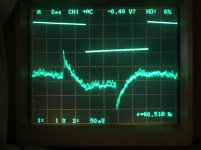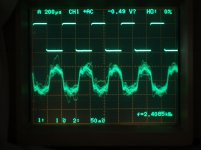....You see the reproduced square waves are pretty close to the input signals. Wiggling in between rest time must be caused by vibration of woofer and/or front baffle.
An interesting signal. That's a tone-burst square wave?
I can see the rough rhythm (duh), but on closer examination, not good square waves. Nor would I dismiss the "wiggling" so readily.
Can you expand the traces?
B.
Ditto, he's already a legend, and a truly nice guy to boot....
Yes, Danley a stand-out for many interesting things he's accomplished (some likely classified by the Army). Good stuff.
But get a grip man, few would say the TH, so beloved at this forum (and only at this forum), qualifies as high sound quality bass.
B.
"Square wave response 1001.3 Hz" I wonder why so specific, could it be this was the only frequency it happened to look like a square wave?
This is the link (for members with different forum settings)
Here is a pretty good square wave
"Square wave response 1001.3 Hz"
An interesting signal. That's a tone-burst square wave?
I can see the rough rhythm (duh), but on closer examination, not good square waves. Nor would I dismiss the "wiggling" so readily.
Can you expand the traces?
B.
Bentront. Yes, The tone-burst signal is used to see overall speaker transient response and make sure the exact timing of TW WF matching.
The wiggling is caused also by a osciloscope cooling fan. Thank you for pointing that. So, I made a muffler by some cushions surrounding the scope. And, I changed the input signal from that of PC software and DAC generated to a normal CR oscillator which usually generate good noise free constant wave.
After the corrections, the pictures are much easier to see.
left to right, 60Hz,600Hz,2400Hz.
You see a shape of step response graph, popular measurement practice in Stereophile review reports, in the 60Hz test picture.
Speaker driver related noise and distortions are found in this pictures, I know.
From a developing TP crossover point of view, I am satisfied with the result.
The sound stage is deep and precise. Percussion is realistic.🙂
Attachments
Hi
Thanks for the replies guys, this is the most data I have found so far.
PB2, to answer your question about what I’m looking for, I designed a speaker for work that while it isn’t made for, or is small enough for the home, it does have the best imaging and sound I’ve ever heard in my living room. I’m trying to get a handle on what hifi speakers do time wise, how many can preserve waveshape and over what bandwidth.
I know there aren’t any pro sound speakers that do
The “goal” on all the full range speakers I’ve been working on is to make a multiway speaker that radiates as if it were a single source in time and space with controlled directivity down to a frequency set by the horns physical size.
I said the H word, yes, the speaker is a horn, part of what it has to do is be about 20dB or more louder than home speakers. The cool part here though is as loud as I would ever have it, they are still loafing.
The idea in this, called a Synergy horn (an extension of the Unity horn) was to use one horn body and drive is along its length, according to the expansion rate which is sort of a high pass filter for horn loading.
The physical position of each frequency range is offset by the phase shift in the crossover network and (when everything is right) you have what looks like a single source and the horn is loaded over a vastly larger range than it could be with only one real driver.
I listening to them last night and thought, “you know I should see what a square wave looks like”.
Anyway I set up and then took some pictures and that prompted my search.
I measured starting at 210Hz, where it starts to look like a square and then every 1/3rd octave above up to 3.15KHz where it poops out and looks like a triangle.
Picture 1 is the speaker, a dusty SH-50 in my living room, mic is an earthworks at about 3 feet although it looks closer from this angle.
Picture 2 is at 250Hz
Picture 3 is at 1KHz
Picture 4 is 2.5Khz
When the weather gets better, I am going to haul one up on the tower and see what square waves look like without all the room reflections.
Anyway, its not a home speaker but maybe you guys will get a kick out of it.
Best,
Tom Danley
I find this post to be a piece of history.


